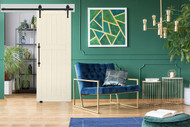How to Pick the Perfect Color Palette for a Room
Jun 10th 2021
Choosing a cohesive color palette for a room’s décor is one of the best things you can do to upgrade your space. Read on for inspiration on how to find the perfect color palette for your room makeover.
Start with Pieces You Already Have
Your room likely comes with pieces that you would like to keep in your new design. For example, you may have wood floors that you don’t plan on re-staining any time soon. In this case, you should count the color of your flooring as part of your color scheme. If you have a centerpiece you want to star in a room — let’s say a yellow lamp — take that as a cue and add yellow as an accent color.
Get Inspired
Make a mood board of images that you find beautiful. Your sources can be outfits, landscapes, or art pieces. Identify several of the colors used in each image. This can give you an idea of the colors and color schemes you enjoy.
Evoke a Feeling
Think about the feeling or vibe you want your room to evoke. Should your room be energetic and fun? Or should it be calming and restful? Once you decide on the feeling, think about the colors you associate with that feeling.
Pick a Color Scheme
The color wheel can be your best friend when it comes to picking a room’s color palette. Color schemes describe how the colors in your palette relate on the color wheel. The three most commonly used types are analogous, monochromatic, and complementary color schemes.
Analogous
Analogous color schemes use colors that are next to each other on the color wheel. Many find these color schemes calming since they are often seen in nature. For example, sunsets often feature yellows, oranges, and reds.
Monochromatic
Monochromatic color schemes use only one hue. They can use different shades of the same hue — for example, darker and lighter shades of red — or they can emphasize the exact same color throughout a room. When using the same color throughout a room, contrast this against white walls, counters, and/or cabinets to avoid an overpowering feeling.
Complementary
If you want a bold feeling in a room, a complementary color scheme may be for you. This is created by using colors that are opposite each other on the color wheel, such as orange and blue.
Limit the Number of Colors
Narrow your colors down to a handful—usually three to five—and pick a base color. The base color is usually neutral, and it’s what will fill most of your space. The base color is usually your wall color, which is why it often isn’t dramatic. Think of this as your canvas color. Other colors can be sprinkled throughout the room in varying amounts, with one or two bright accent colors that add a pop of color and interest.
Don’t Forget Your Doors
Doors are often forgotten in room decorating plans, but when planned appropriately, they can be a focal point. Consider adding a barn door for an accented pop against your base color. Because barn doors rest against the wall, they add a dimension of character that swinging doors can lack.
No matter the color palette you decide on, we have the door for you. Browse our selection today to find the perfect accent door for your room makeover.
